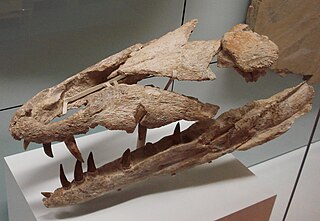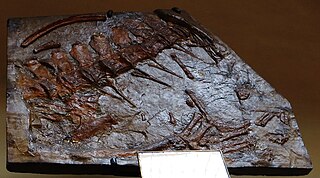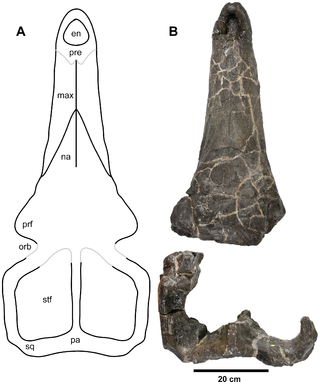
Dakosaurus is an extinct genus of crocodylomorph within the family Metriorhynchidae that lived during the Late Jurassic and Early Cretaceous. It was large, with teeth that were serrated and compressed lateromedially. The genus was established by Friedrich August von Quenstedt in 1856 for an isolated tooth named Geosaurus maximus by Theodor Plieninger in 1846. Dakosaurus was a carnivore that spent much, if not all, its life out at sea. The extent of its adaptation to a marine lifestyle means that it is most likely that it mated at sea, but since no eggs or nests have been discovered that have been referred to Dakosaurus, whether it gave birth to live young at sea like dolphins and ichthyosaurs or came ashore like turtles is not known. The name Dakosaurus means "biter lizard", and is derived from the Greek dakos ("biter") and σαῦρος -sauros ("lizard").
Aggiosaurus is an extinct genus of geosaurine metriorhynchid crocodyliform known from the Late Jurassic of Nice, southeastern France. It contains a single species, Aggiosaurus nicaeensis, which was named by H. Ambayrac in 1913.

Metriorhynchus is an extinct genus of marine crocodyliform that lived in the oceans during the Late Jurassic. The type species, M. brevirostris was named in 1829 as a species of Steneosaurus before being named as a separate genus by the German palaeontologist Christian von Meyer in 1832. The name Metriorhynchus means "Moderate snout", and is derived from the Greek Metrio- ("moderate") and -rhynchos ("snout").

Metriorhynchidae is an extinct family of specialized, aquatic metriorhynchoid crocodyliforms from the Middle Jurassic to the Early Cretaceous period of Europe, North America and South America. The name Metriorhynchidae was coined by the Austrian zoologist Leopold Fitzinger in 1843. The group contains two subfamilies, the Metriorhynchinae and the Geosaurinae. They represent the most marine adapted of all archosaurs.

Enaliosuchus is a dubious genus of extinct marine crocodyliform within the family Metriorhynchidae that lived during the Valanginian stage of the Early Cretaceous. It is known from fossil remains found in France and Germany and it was first described in 1883,. The name Enaliosuchus means "Marine crocodile", and is derived from the Greek Enalios- ("marine") and -suchos ("crocodile"). Two species are known: the type species E. macrospondylus, described in 1883, and the second species E. schroederi, described in 1936, which was likely the same animal as E. macrospondylus.

Geosaurus is an extinct genus of marine crocodyliform within the family Metriorhynchidae, that lived during the Late Jurassic and the Early Cretaceous. Geosaurus was a carnivore that spent much, if not all, its life out at sea. No Geosaurus eggs or nests have been discovered, so little is known of the reptile's lifecycle, unlike other large marine reptiles of the Mesozoic, such as plesiosaurs or ichthyosaurs which are known to give birth to live young out at sea. Where Geosaurus mated, whether on land or at sea, is currently unknown. The name Geosaurus means "Mother of Giants lizard", and is derived from the Greek Ge- and σαῦρος -sauros ("lizard"). The name Geosaurus was established by the French naturalist Georges Cuvier in 1824.

Thalattosuchia is a clade of mostly marine crocodylomorphs from the Early Jurassic to the Early Cretaceous that had a cosmopolitan distribution. They are colloquially referred to as marine crocodiles or sea crocodiles, though they are not members of Crocodilia and records from Thailand and China suggest that some members lived in freshwater. The clade contains two major subgroupings, the Teleosauroidea and Metriorhynchoidea. Teleosauroids are not greatly specialised for oceanic life, with back osteoderms similar to other crocodyliformes. Within Metriorhynchoidea, the Metriorhynchidae displayed extreme adaptions for life in the open ocean, including the transformation of limbs into flippers, the development of a tail fluke, and smooth, scaleless skin, and probably gave live birth, seemingly uniquely among archosaurs.

Neustosaurus is a genus of marine crocodyliform from the Early Cretaceous. Neustosaurus was a carnivore that spent much, if not all, its life out at sea. No Neustosaurus eggs or nest have been discovered, so little is known of the reptile's lifecycle, unlike other large marine reptiles of the Mesozoic, such as plesiosaurs or ichthyosaurs which are known to give birth to live young out at sea. Where Neustosaurus mated, whether on land or at sea, is currently unknown. The name Neustosaurus means "Swimming lizard", and is derived from the Greek Neustos- ("swimming") and σαῦρος -sauros ("lizard").
Purranisaurus is an extinct genus of marine crocodyliform from the Middle to Late Jurassic period of Chile and Vaca Muerta of Argentina. Rusconi originally regarded Purranisaurus potens to be a plesiosaur; however, Gasparini demonstrated that it was in fact a metriorhynchid crocodyliform, and that may be a junior synonym of Metriorhynchus. It was about 3.3 m (11 ft) long.

Plesiosuchus is an extinct genus of geosaurine metriorhynchid crocodyliform known from the Late Jurassic of Dorset, England and possibly also Spain. It contains a single species, Plesiosuchus manselii.

Rhacheosaurus is an extinct genus of marine crocodyliform belonging to the family Metriorhynchidae. The genus was established by Christian Erich Hermann von Meyer in 1831 for skeletal remains from the Tithonian of Germany. It was a relatively small reptile, measuring between 1.39 and 1.57 m long.

Suchodus is an extinct genus of marine crocodyliform from the Middle to Late Jurassic period of England and France. It measured between 3.3 and 4.7 m in total body length.

Aeolodon is an extinct genus of teleosaurid crocodyliform reptile from the Late Jurassic (Tithonian) of Germany and France that was initially named as a species of Crocodylus in 1814. Although previously synonymized with Steneosaurus, recent cladistic analysis considers it distantly related to the Steneosaurus type species and the type species is A. priscus, named in 1830 and described in 2020.

Neptunidraco is an extinct genus of carnivorous marine crocodyliform which lived during the middle Jurassic period in what is now northeastern Italy. It is known from a partial skeleton recovered from the nodular limestone of the Rosso Ammonitico Veronese Formation. This specimen had been provisionally referred to an unnamed species of Late Jurassic Metriorhynchus or Geosaurus. Neptunidraco was named by Andrea Cau and Federico Fanti in 2011 and the type species is Neptunidraco ammoniticus. The "Portomaggiore crocodile" is the most complete specimen of an Italian metriorhynchid to date and the oldest known metriorhynchid.

Metriorhynchoidea is an extinct superfamily of thalattosuchian crocodyliforms from the Early Jurassic to the Early Cretaceous of Europe, North America and South America. Metriorhynchids are fully aquatic crocodyliforms. Named by Fitzinger, in 1843, it contains the basal taxa like Teleidosaurus, Zoneait and Eoneustes and the family Metriorhynchidae. An unnamed taxon is known from Chile.

Torvoneustes is an extinct genus of metriorhynchid thalattosuchian. It is known from skull and postcranial remains found in the Kimmeridge Clay Formation of Dorset and Wiltshire, England, the Virgula Marls of Switzerland and also from Oaxaca, Mexico . The holotype skull of the type species was initially assigned to the species Metriorhynchus superciliosus. Postcranial remains were later discovered from the same quarry as the skull, and then these specimens were recognised as belonging to a new species of Dakosaurus, as D. carpenteri. The species was named to honour Simon Carpenter, an amateur geologist from Frome in Somerset, who discovered the fossils.

Macrospondylus is an extinct genus of machimosaurid teleosauroid crocodyliform from the Early Jurassic (Toarcian) of Europe. Fossils are known from the Posidonia Shale of Germany, the Whitby Mudstone of the United Kingdom, and the "schistes bitumineux" of Luxembourg.

Geosaurinae is a subfamily of metriorhynchid crocodyliforms from the Middle Jurassic to the Early Cretaceous of Europe, North America and South America. Named by Richard Lydekker, in 1889, it contains the metriorhynchids Suchodus, Purranisaurus, Neptunidraco, Tyrannoneustes, Torvoneustes, Dakosaurus, Geosaurus and Plesiosuchus. The last four taxa form a tribe within Geosaurinae, the Geosaurini. Geosaurinae is one of two subfamilies of Metriorhynchidae, the other being Metriorhynchinae.

Metriorhynchinae is a subfamily of metriorhynchid crocodyliforms from the late Middle Jurassic to the Early Cretaceous of Europe, North America and South America. Named by Fitzinger, in 1843, it contains the metriorhynchids Maledictosuchus, Gracilineustes, Metriorhynchus, Cricosaurus and Rhacheosaurus. The last three taxa form a tribe within Metriorhynchinae, the Rhacheosaurini. Metriorhynchinae is one of two subfamilies of Metriorhynchidae, the other being Geosaurinae.

Thalattosuchus is an extinct genus of marine crocodyliform that lived in the oceans during the Middle to Late Jurassic. Thalattosuchus was named in 2020. Thalattosuchus was a carnivore that spent much, if not all, its life out at sea. No Thalattosuchus eggs or nests have been discovered, so little is known of the reptile's life cycle, unlike other large marine reptiles of the Mesozoic, such as plesiosaurs or ichthyosaurs which are known to have given birth to live young out at sea. Where Thalattosuchus mated, whether on land or at sea, is currently unknown. The name Thalattosuchus means "sea crocodile".





















